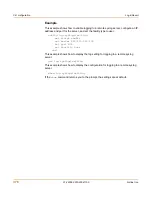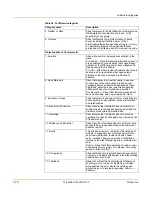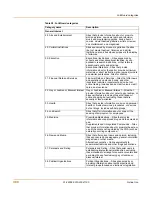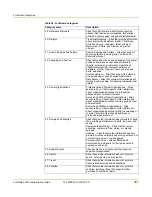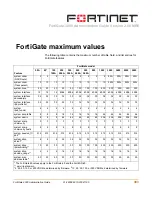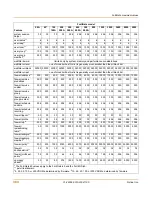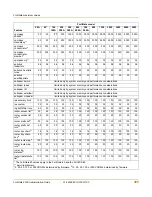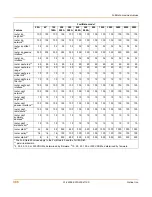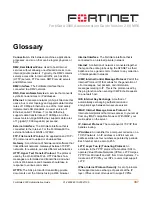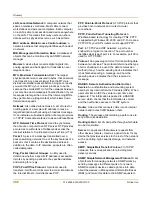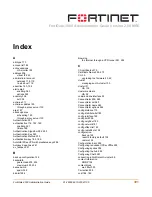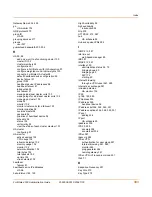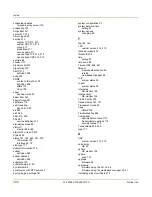
388
01-28006-0010-20041105
Fortinet Inc.
Glossary
LAN, Local Area Network
: A computer network that
spans a relatively small area. Most LANs connect
workstations and personal computers. Each computer
on a LAN is able to access data and devices anywhere
on the LAN. This means that many users can share
data as well as physical resources such as printers.
MAC address, Media Access Control address
: A
hardware address that uniquely identifies each node of
a network.
MIB
,
Management Information Base
: A database of
objects that can be monitored by an SNMP network
manager.
Modem
: A device that converts digital signals into
analog signals and back again for transmission over
telephone lines.
MTU
,
Maximum Transmission Unit
: The largest
physical packet size, measured in bytes, that a network
can transmit. Any packets larger than the MTU are
divided into smaller packets before being sent. Ideally,
you want the MTU your network produces to be the
same as the smallest MTU of all the networks between
your machine and a message's final destination. If your
messages are larger than one of the intervening MTUs,
they get broken up (fragmented), which slows down
transmission speeds.
Netmask
: Also called subnet mask. A set of rules for
omitting parts of a complete IP address to reach a
target destination without using a broadcast message.
It can indicate a subnetwork portion of a larger network
in TCP/IP. Sometimes referred to as an Address Mask.
NTP
,
Network Time Protocol
: Used to synchronize
the time of a computer to an NTP server. NTP provides
accuracies to within tens of milliseconds across the
Internet relative to Coordinated Universal Time (UTC).
Packet
: A piece of a message transmitted over a
packet-switching network. One of the key features of a
packet is that it contains the destination address in
addition to the data. In IP networks, packets are often
called datagrams.
Ping, Packet Internet Grouper
: A utility used to
determine whether a specific IP address is accessible.
It works by sending a packet to the specified address
and waiting for a reply.
POP3, Post Office Protocol
: A protocol used to
transfer e-mail from a mail server to a mail client across
the Internet. Most e-mail clients use POP.
PPP, Point-to-Point Protocol
: A TCP/IP protocol that
provides host-to-network and router-to-router
connections.
PPTP, Point-to-Point Tunneling Protocol
: A
Windows-based technology for creating VPNs. PPTP
is supported by Windows 98, 2000, and XP. To create a
PPTP VPN, your ISP's routers must support PPTP.
Port
: In TCP/IP and UDP networks, a port is an
endpoint to a logical connection. The port number
identifies what type of port it is. For example, port 80 is
used for HTTP traffic.
Protocol
: An agreed-upon format for transmitting data
between two devices. The protocol determines the type
of error checking to be used, the data compression
method (if any), how the sending device indicates that
it has finished sending a message, and how the
receiving device indicates that it has received a
message.
RADIUS
,
Remote Authentication Dial-In User
Service
: An authentication and accounting system
used by many Internet Service Providers (ISPs). When
users dial into an ISP they enter a user name and
password. This information is passed to a RADIUS
server, which checks that the information is correct,
and then authorizes access to the ISP system.
Router
: A device that connects LANs into an internal
network and routes traffic between them.
Routing
: The process of determining a path to use to
send data to its destination.
Routing table
: A list of valid paths through which data
can be transmitted.
Server
: An application that answers requests from
other devices (clients). Used as a generic term for any
device that provides services to the rest of the network
such as printing, high capacity storage, and network
access.
SMTP, Simple Mail Transfer Protocol
: In TCP/IP
networks, this is an application for providing mail
delivery services.
SNMP
,
Simple Network Management Protocol
: A set
of protocols for managing networks. SNMP works by
sending messages to different parts of a network.
SNMP-compliant devices, called agents, store data
about themselves in Management Information Bases
(MIBs) and return this data to the SNMP requesters.
Summary of Contents for FortiGate 3000
Page 18: ...Contents 18 01 28006 0010 20041105 Fortinet Inc ...
Page 52: ...52 01 28006 0010 20041105 Fortinet Inc Changing the FortiGate firmware System status ...
Page 78: ...78 01 28006 0010 20041105 Fortinet Inc FortiGate IPv6 support System network ...
Page 86: ...86 01 28006 0010 20041105 Fortinet Inc Dynamic IP System DHCP ...
Page 116: ...116 01 28006 0010 20041105 Fortinet Inc FortiManager System config ...
Page 122: ...122 01 28006 0010 20041105 Fortinet Inc Access profiles System administration ...
Page 252: ...252 01 28006 0010 20041105 Fortinet Inc CLI configuration Users and authentication ...
Page 390: ...390 01 28006 0010 20041105 Fortinet Inc Glossary ...
Page 398: ...398 01 28006 0010 20041105 Fortinet Inc Index ...



